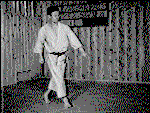Shotokan Karate Team Kata
Commish: Kinh Tieu
 |
 |
Vital Information
Objective: perform traditional Shotokan karate kata as a team, synchronized and with spirit! A video of the kata to be performed is in /home/vis7/data/tieu/kata.avi (takes a while to load over the web). You can't hear it, but there should be a kiai (loud yell) on the third rising block and the third lunge punch.When: Saturday 1/22/2000, 11:30am.
The Dojo: 8th floor playroom.
Demos: there will be demos of kata, possibly team kata and perhaps even kumite (sparring)!
Shotokan
Shotokan Karate-do was created by Gichin Funakoshi. Shotokan is a blend of martial arts from China and Okinawa. Kara means "empty" and "te" means hand. Today, there are many organizations which practice and promote Shotokan including the Japan Karate Association, Shotokan Karate of America, International Shotokan Karate Federation, Shotokan Karate International, and others (see www.jkadojo.com for more information). Local clubs in this area include SKA MIT and JKA Boston.Kata
Kata means "form". It is a set of pre-arranged moves with a specific timing and application. Katas typically consist of about 25-50 movements and take about 1-2 minutes to perform. The purpose of kata is provide the karateka with a way to practice putting her techniques together. Three primary goals to keep in mine when performing kata are: (1) strength and weakness of power, (2) expansion and contraction of the body, (3) slowness and speed of techniques.Teams will be given 15 minutes to learn the "Heian Shodan" kata which means "peace, calm, tranquility; first level".
PronunciationShotokan: sho-toh-kanhkarate: kah-rah-teh kata: kah-tah heian shodan: he-ann sho-danh |

|
Scoring
Note that scoring is heavily weighted towards participation.
| Quality | Description | Points |
| Participation | kata looks cool with big groups | 2/participant |
| Synchronicity | everyone does the moves at the same time | 1-5 |
| Speed | slow moves really slow, fast moves really fast | 1-3 |
| Power | your punches and kicks should break boards | 1-3 |
| Focus | how serious the team looks, no giggling | 1-3 |
| Kiai | a strong, loud yell emanating from the navel that should instill fear in your opponent | 1-3 |
| Japanese | announcing the kata name in Japanese | 1-3 |
| Barefoot | no socks or shoes on the carpet | 1/pair |
| Attire | wearing karate-like uniforms, (e.g., robe, belt) | 3/uniform |
Of course, only the order of the team scores matters for overall Olympics scoring.

Kinh H. Tieu (tieu@ai.mit.edu)
Last modified: Tue Feb 15 14:20:22 EST 2000